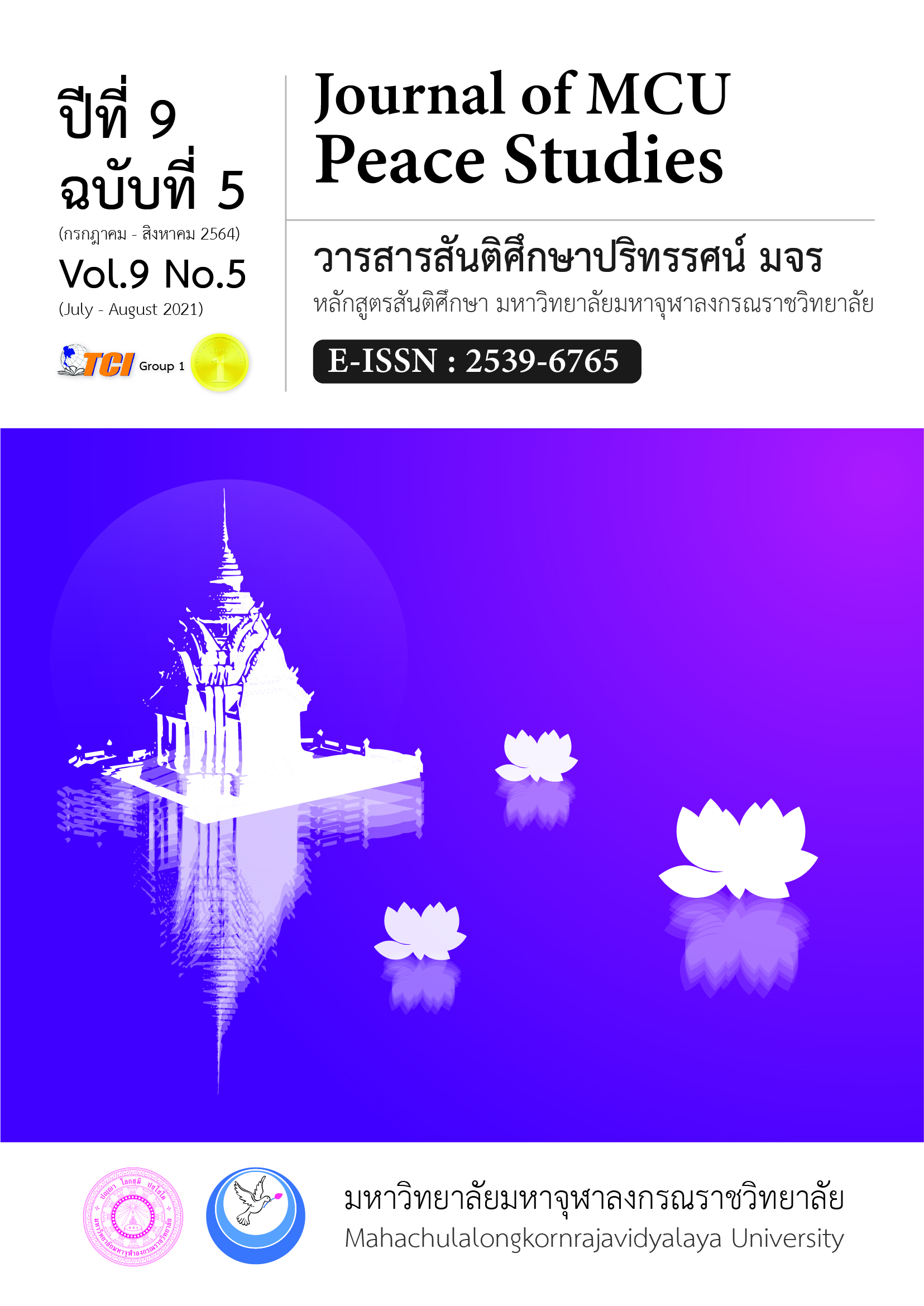The Attribute Development Strategy of Administrator in New Normal Era Under Primary Educational Service Area Office
Main Article Content
Abstract
This study aimed to 1) investigate the attribute development strategy of administrator in the new normal era under the Primary Educational Service Area Office, 2) construct and develop the attribute development strategy of administrator in the new normal era under the Primary Educational Service Area Office, and 3) assess the attribute development strategy of administrator in the new normal era under the Primary Educational Service Area Office The sample consisted of 395 school administrators of the Primary Educational Service Area Office in the academic year 2020, derived from multi-stage sampling. Besides, the sample included 99 strategy and satisfaction assessors, who were willing and voluntary to join the research group, and the five respondents in the interview. The research instruments were questionnaires, test forms, interview forms, behavioral observation forms, and satisfaction assessments forms. To analyze the data, the researcher conducted the statistics consisting of frequency, percentage, mean, standard deviation, t-test by dependent samples, and the content analysis for the qualitative study. The result revealed that 1) the overall practicality of the attribute development strategy of administrator in the new normal era under the Primary Educational Service Area Office showed a high level in all aspects. 2) The result of strategy construction and attribute development of administrator in the new normal era under the Primary Educational Service Area Office indicated the six strategies, namely initiative and creative mind, intelligence, self-confidence, responsibility, achievement orientation, and moral. 3) The assessment on strategy and satisfaction of executive attribute development in the new normal era under the Primary Education Service Area Office was at the highest level in an overview.
Article Details
Views and opinions expressed in the articles published by The Journal of MCU Peace Studies, are of responsibility by such authors but not the editors and do not necessarily reflect those of the editors.
References
Barnard, C. I. (1938). Functions of an Executive. Cambridge, MA: Harvard University Press.
Barnard, C. I. (1969). Organization and Management. Cambridge, MA: Harvard University Press.
Bass, B. M. (2008). Bass & Stogdill’s Handbook of Leadership. (4th ed.). New York: Free Press.
Bass, B. M., & Bass, R. (1970). The Bass Handbook of Leadership. (4th ed.). New York: Free Press.
Benson, J. K. (1975). The Interorganizational Network as a Political Economy. Administration Science Quarterly, 20(2), 229–249.
Boonsiripun, M. (2020). Get to know "New Normal" edition of the Royal Thai Council. Retrieved May 6, 2020, from https://news.thaipbs.or.th/content/292126.
Chung, K. H., & Megginson, L, C. (1981). Organization Behavior Development Managerial Skills. New York: Harper and Row Pubishers.
Corsini, R. J. (1999). Stereotype. In The dictionary of psychology. Philadelphia, PA: Brunner/Mazel.
Duncan, O.D. (1975). Introduction to structural equation models. New York: Academic Press.
Ghiselli, E. E., (1971). Managerial Talent. American Psychologist, 16(10), 39-94.
Grant, K. P., Graham T. S., & Heberling, M. E. (2001). The project manager and project team involvement: Implications for project leadership. Journal of Leadership Studies, 7(4), 32– 42.
Guilford, J. P. (1967). The nature of human intelligence. New York: McGraw-Hill.
Hoy, W. K., & Miskel, C. G. (2013). Education and Administration. (9th Ed.). New York: McGraw Hill.
Hoy, W. K., & Miskel, C. G. (2013). Educational Administration: Theory, Research and Practice. (9th ed.). Singapore: McGraw-Hill.
Karaköse, T. ( 2007) . High School Teachers’ Perceptions Regarding Principals’ Ethical Leadership in Turkey. Asia Pacific Education Review, 8(3), 464–477.
Khamdit, S. (2018). Educational Leadership: Leadership in Thai Society. (3rd ed.). Bangkok: Chulalongkorn University.
Mann, R. D. (1959). A Review of the Relationship between Personality and Performance in Small Groups. Psychological Bulletin, 56(4), 241-270.
National Institute of Educational Testing Service (Public Organization) , ( 2020) . Important information about O-NET Academic Year 2020 . Retrieved May 6, 2020, from https://www.niets.or.th/th/catalog/view/212.
Runcharoen, T. (2003). To become a professional administrator. Bangkok: khaofang.
Runcharoen, T. (2 010). Professionalism in organizing and administering education. Bangkok: khaofang.
Sararatana, W. (2014) . A new paradigm in education Case view on 21st century education. Bangkok: Thiphawisut.
Shrauger, J. S., & Schohn, M., (1995). Self-confidence in college students: Conceptualization, measurement, and behavioral implications. Assessment, 2(3), 255–278.
Sinlarat, P. (2006). Creative and Productive Education. Bangkok: Chulalongkorn University.
Sinlarat, P. (2018). Educational Leadership: Thought Leaders. (3rd ed.). Bangkok: Chulalongkorn University.
Stogdill, R. M. (1948). Personal Factors Associated with Leadership: A Survey of the Literature. Journal of Psychology, 25(1), 35-71.
Stogdill, R. M., (1974). Handbook of leadership. New York: Free Press.
Torrance, E. P., (1963). Education and the creative potential. Minneapolis, MN: The University of Minnesota Press.
Wonghai, W., & Phatphon, M. ( 2 0 2 0 ) . Learning design on New Normal. Graduate school Srinakharinwirot University, Bangkok Ben.
Wright, P. M. et al. (1994). On the meaning and measurement of goal commitment. Journal of Applied Psychology, 79(6), 795–803.
Yamane, T. (1973). Statistics: An Introductory Analysis. (3rd Ed.) New York: Harper and Row Publications.
Yukl, G.A. (2002). Leadership in Organizations. (5th ed.) New Jersey: Prentice Hall, Upper Saddle River.
Zaccaro, S., Kemp, C., & Bader, P. (2004). Leader traits and attributes. In J, Antonakis, A, Cianciolo, & R Sternberg (Eds.), The Nature of Leadership. Thousand Oaks, CA: Sage Publications.


